Project Log: Sunday,
October 25, 2009
Home Page >
The Project >
Project Logs > 10/25/09 |
Much of the deck hardware had been
removed long ago by the previous owner, but several
stanchion bases remained, along with a few padeyes, bow
cleat, and the occasional thing here or there. This
all had to come off. Rather than waste time unbolting
each piece, with such good access afforded by the interior
strip-out, I chose to cut the nuts off from below.
Using an angle grinder equipped with stainless steel cutoff
wheel, I buzzed the nuts off all the hardware in the forward
two-thirds of the boat (everything forward of the cockpit),
as well as the bolts securing the toerail, which I also
needed to remove. There were a lot of bolts along the
hull-deck joint, as the joint was secured through the
overlapping flanges with bolts every 12" or so on center, in
addition to the bolts securing the toerail through the
joint. In a few places, therefore, it was unclear
which bolts were which, and I got confused and cut off the
wrong nuts--the ones on the bolts intended to secure the
hull-deck joint rather than the toerail. This wasn't a
worry, but I had to check myself several times during the
process.
It took about an hour to cut all the studs,
and consumed 4 cutoff wheels. I didn't crawl back into
the black hole beneath the cockpit at this point, so the aft
sections of toerail remained bolted in place for the moment.
Since I was already dirty and dusty from crawling about
the interior, I decided to do some grinding. The
disgusting overhead was really bothering me, so I spent the
next 1.75 hours grinding the overhead in the main cabin and
adjacent areas of the inside of the cabin trunk, as far
forward as the doghouse bump. Even though all this
would eventually be covered, I had to smooth the thick beads
of resinous adhesive enough to accept new installations in
the future, not to mention sufficiently to allow me to
stomach the appearance for the foreseeable future.
The process went well enough, and the material sanded
without difficulty--simply time-consuming because of the
thickness and quantity of the beads (most of which had never
contacted the liner, interestingly enough). I started
using a 7" grinder equipped with a 36 grit Powerflex flap
disc, switched to my 4-1/2" grinder after a short time when
I decided the smaller tool worked just as quickly (maybe
more so) for this particular task, but was far easier (and
lighter) to handle; I saved the big grinder and its larger
pads for the future interior hull sanding.
In any
event, I felt much better with roughly half of the overhead
sanded, clean, and ready for new work when the time came.
The end result was smooth enough for the intended purpose
and requirement, and looked much better.
|
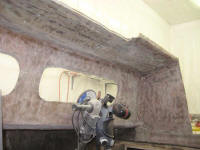
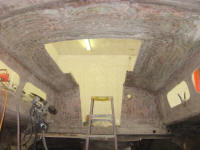
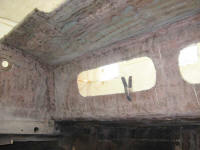 |
After a break to take care of some other things on
what was a fine fall day outside, I returned to the boat to
remove the deck hardware and toerail. The various
hardware came up without difficulty, and I removed the cut
bolts and stored the hardware in a container for later
assessment. There were still a few bits to remove:
one stanchion base (I'd have to go into the cockpit locker
to cut those bolts), and several bronze deck plates (on the
poop deck and Dorade boxes near the mast).
Additionally, I planned to remove the mast step and the
bronze stem casting. |
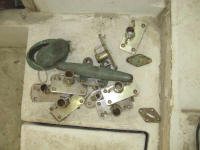 |
The toerail came up without much of a fuss. On
this boat, the previous owner had modified the toerail with
several cutouts, ostensibly for deck drainage, so the short
sections came up independently and easily. At the
extreme forward end, it'd been too difficult to cut the nuts
from inside, so I used a reciprocating saw to cut through
the rail and the remaining few bolts from the foredeck.
(I had no intention of saving or reusing the existing
toerail.) As I went, I scraped up the sealant from
beneath the toerail.
Of course, now that I'd begun
the removal, I couldn't stop, so I had to continue with the
after sections--where I had yet to cut the bolts. Not
wanting to crawl below, and having had an easy time cutting
the forward part of the rail (and its fasteners) from the
foredeck, I decided to use the reciprocating saw to cut the
rail and fasteners around the stern quarters of the boat.
This ended up taking significantly more effort than I'd
hoped, as well as many more saw blades than I expected.
For some reason, the fasteners here were extremely resistant
to cutting, and the saw blades immersed in the wood quickly
overheated and dulled.
Eventually, I got it done,
though not with the ease with which I'd expected.
Additionally, I found that the port after sections were
secured with extremely tenacious sealant, which didn't
prevent the wood's removal, but did end up being a lot more
time-consuming to scrape off, unlike the sealant that had
been beneath the forward sections.
Despite all this,
the afternoon hardware/toerail session and cleanup only
required two and a half hours. I felt much better
afterwards: a stripped deck is always indicative of
solid progress somehow, an important part of the
deconstruction process that necessarily precedes any
rebuilding. |
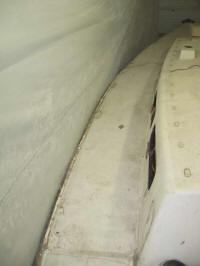
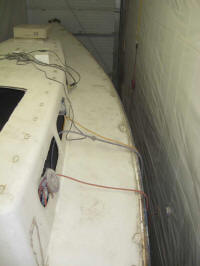
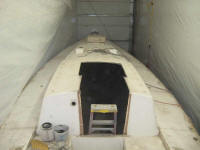
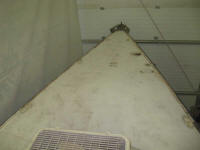
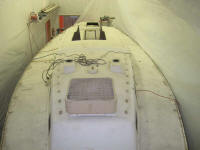
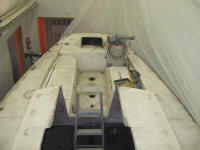 |
Total Time Today: 5.25 hours |
Previous |
Next |
|
|